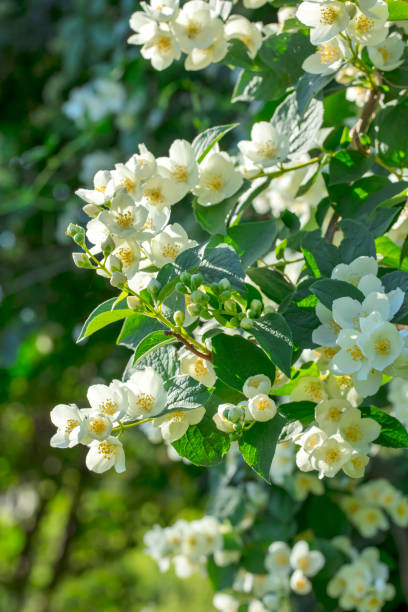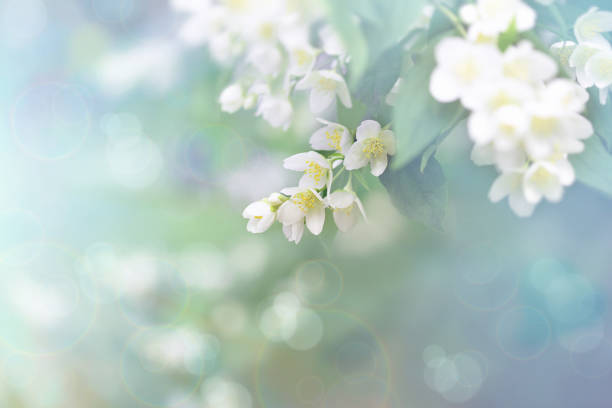When Do Jasmine Bloom?
Jasmine blooms in clusters from the beginning of spring until summer. Depending on the variety, the sweet flowers are typically cream, white, or yellow in color and will pollinate insects to their nectar.
When Jasmine blooms, we can say that it blooms during the summer months. As a result, on the arrival of spring and summer, the development of flowering begins. The flowers start to develop in late spring when temperatures have already risen. There is no danger of frost in the forecast.
White Jasmine blooms from spring to fall during the growing season before entering a dormant period in October that lasts until March. Mature white Jasmine can reach a height of 20 to 30 feet and spread out to a width of 7 to 15 feet. These deciduous to semi-evergreen shrubs produce small, white, or pink fragrant flowers about 1 inch across. They have 5 to 9 leaflets, each about 2 1/2 inches long. They have green leaves that are 5 to 9 leaflets long and are about 1 inch across. The growth habit of white Jasmine is either sprawling or trailing.

Table of Contents
How Long Do Jasmine Flowers Last?
When given enough sunlight and the proper watering and feeding, jasmine flowers will remain open and fragrant for several months, allowing you to enjoy their fragrance.
During the Spring or Summer, Jasmine will flower if it receives at least 6 hours of direct sunlight per day, but the more sunlight, the better for flowering and plant health.
If the Jasmine receives less than 6 hours of direct sunlight per day, it may become stressed and lose its ability to flower.
There are different types of Jasmine flowers that you can grow. Common Jasmine ( Jasminum officinale ), Spanish Jasmine ( Jasminum grandiflorum ), and Arabian Jasmine ( Jasminum sambac ) are some of the most well-known jasmine flower names. According to the Pacific Horticulture Society, Jasminum officinale, also known as Common Jasmine, can be grown in zones 7-10 or as cold as zone 6 with some additional winter protection, depending on the variety. In terms of hardiness, Spanish Jasmine can be grown in zones 8 to 10, while Arabian Jasmine can be grown in zones 9 to 11.
Jasmine produces its first flush of blossoms in the spring, with subsequent flowers blooming and dying off regularly until the end of the growing season in late fall. This plant takes advantage of the extreme temperature difference between night and day during the late winter and early spring to form flower buds. In fact, according to the Chicago Botanic Garden, a 15-degree temperature change is required for flowering to be successful in the spring and summer. According to the USDA, this is true for the vast majority of jasmine cultivars, including Jasminum officinale. Until temperatures rise in the early summer, a mild winter combined with a cool spring may prevent flowering from taking place.
The length of time that jasmine flowers remain in bloom on the plant after they have opened varies from plant to plant and from season to season. The growing conditions impact the length of time it takes for flowers to bloom. Overwatering your jasmine plant, for example, can cause the flowers to drop off before they are ready. In most cases, jasmine flowers will remain open and on the plant for several days after being picked.

What Should You Do If Your Jasmine Flowers Aren’t Blooming?
You may be concerned if your Jasmine isn’t flowering whether you’re growing it indoors or outdoors. You may wonder why your jasmine plant is not blooming after all your hard work. Continue reading to learn why your jasmine plant has no blooms.
Why Doesn’t Jasmine Bloom?
Perhaps your indoor jasmine plant appears to be in good health, with lush green foliage. You’ve fed and watered it religiously, but the jasmine flowers aren’t blooming. Perhaps the issue is one of fertilization. An excessive amount of nitrogen fertilizer will direct energy away from the formation of blooms and toward the growth of foliage. This can also be an issue when the majority of the jasmine flowers are not blooming.
Fertilize with a low-nitrogen, or even no-nitrogen, plant food. Phosphorus-rich plant food frequently causes plants to bloom. Perhaps all of that extra attention included relocating your potted Jasmine to a larger container. Be patient; Jasmine needs to be root bound to bloom. This plant requires adequate air circulation to thrive. Plants that are in good health are more likely to bloom than those that are in need. Place this plant near open windows or a fan to help circulate air.
The non-flowering Jasmine may be growing in the incorrect conditions. Light and the proper temperature are required for blooms from dormant Jasmine. During the day, temperatures should range between 65 and 75 degrees Fahrenheit (18 and 24 degrees Celsius).
When the blooms on your jasmine plant have faded, prune it. If you can’t prune now, make sure you get it done by midsummer. When pruning later in the season, buds that have already formed may be removed from the tree. Heavy pruning is encouraged for this plant. It will encourage more and larger blooms if done at the right time.
Blooms’ Rest Period
If you want your indoor blooming Jasmine to produce winter blossoms, you must give it a period of rest in the autumn. The nights should be dark during this period. Identify the non-flowering Jasmine that grows in these circumstances. If you have issues with streetlights shining through your windows at night, you can store the jasmine plants that aren’t blooming in a closet during the night.
Outdoor Jasmine that is not producing flowers can be protected with a dark, lightweight landscape covering or even a sheet. Still, it must be removed as soon as the sun appears in the sky. Even if the Jasmine does not have any blooms, it will require light during the day. During this rest period, only a small amount of water should be applied to the non-flowering Jasmine. Withhold fertilization for a period of four to five weeks during this time. Maintain temperatures between 40 and 50 degrees Fahrenheit (4 and 10 degrees Celsius) during the resting period of the jasmine flowers that are not in bloom.
When flowers begin to appear on a jasmine plant that has not been blooming, move it to a location where it will receive 6 hours of light per day for the next several weeks. Temperatures between 60-65° Fahrenheit (16-18° Celsius) are appropriate at this time. Watering and feeding should be resumed regularly. The jasmine plant will require humidity during this period. Place a pebble tray filled with water in the vicinity of the jasmine plant that has begun to bloom.
You can even put the potted Jasmine on the pebble tray, but make sure to keep it in a saucer so that it does not absorb any water and become soggy. Soggy roots on this plant will also delay or prevent blooming, so only water the jasmine plant when the soil is dry.
